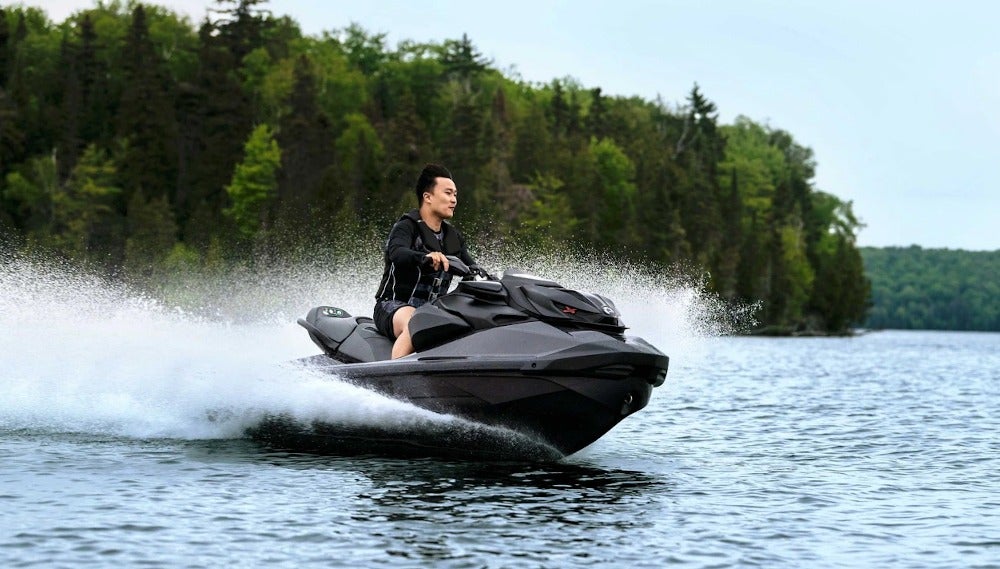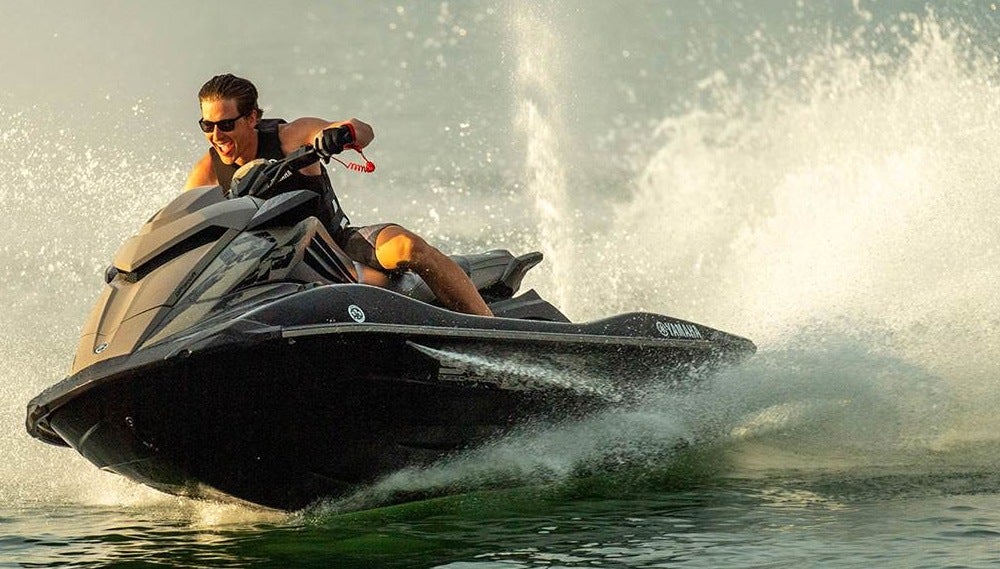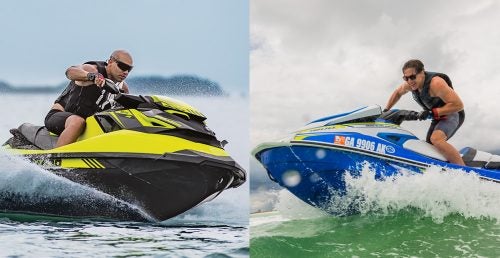Top Guns: Sea-Doo RXP-X 300 vs. Yamaha GP1800R SVHO
Sea-Doo vs. Yamaha: Which suits you better? Should you buy the RXP-X 300 or the GP1800R SVHO?
With a Top Gun sequel tearing up the box office and plenty of performance enthusiasts feeling “the need for speed,” a comparison between two of the hottest personal watercraft on the market seems fitting. After all, arguably no other production models currently combine this much power with this much agility. Sea-Doo vs. Yamaha—which one to buy?
Here’s how the PWC market’s Top Guns rate when they go head-to-head in a dogfight.
 Spec to Spec
Spec to Spec
YAMAHA GP1800R SVHO
Engine: 1,812cc supercharged/intercooled four-cylinder
Fuel Capacity: 18.5 gallons
Storage Capacity: 28.4 gallons
Seating Capacity: 3
MSRP: $15,349
SEA-DOO RXP-X 300
Engine: 1,630cc supercharged/intercooled triple cylinder
Fuel Capacity: 18.5 gal.
Storage Capacity: 40.6 gal.
Seating Capacity: 1 (2 w/optional passenger seat)
MSRP: $16,099
In terms of physical presence, the two craft are quite similar. The RXP-X measures in at 130.6” in length, 49.2” in width, and has a dry weight of 780 pounds. The GP1800R specs out at 131.9” in length, 48.8” in width, and has a dry weight of 754 pounds. Fuel load is an identical 18.5 gallons. Sea-Doo holds the storage advantage, 40.6 gallons to the Yamaha’s 28.4, but cargo room likely doesn’t rank high in the target buyer’s priorities.
Though likely ridden solo, the GP1800R is technically a three-passenger model. In stock form, the RXP-X is now only a solo craft, with a second-passenger seat extension available as an option.Standout features include electronic reverse/deceleration systems on both craft (Sea-Doo’s Intelligent Brake & Reverse/Yamaha’s RiDE). The RXP-X adds an Ergolock saddle that can be adjusted fore and aft to fine tune the fit to the rider, angled foot wedges for leverage, acceleration profiles (Touring/Sport), and the Launch Control enhancement that attempts to best adjust trim angle for best acceleration.
The GP1800R gets a similar Launch Control feature, cruise control and no-wake modes and an Auto Trim feature that automatically selects the best trim for speed, whether in a corner or straight-line drag run.
The spec that most will want to know is horsepower. Be aware, it’s a number that can be slightly modified for marketing purposes and one that, in many ways, is not a true apples-to-apple’s indicator of a craft’s actual power on the water. EPA testing reveals the RXP-X 300 is powered by a supercharged Rotax 1630 ACE engine producing 291hp at 8,000 RPM. Yamaha’s GP1800R SVHO uses a 1,812cc Super Vortex High Output engine producing around 247hp at 7,500 RPM. Hull and pump design play a significant role in how that horsepower is delivered to the water. With equal 18.5-gallon fuel loads, the Yamaha enjoys a slight weight advantage. Both craft are subject to speed governors that tame their true potential.
 Performance
Performance
Better indicators than horsepower are on-water results. Disclaimer? Our testing of each boat was done separately, in different locations and different, although relatively similar summertime conditions. Our results, however, fall in line with testing done by aftermarket performance leader Riva Racing.
In terms of pure top speed, both machines will consistently hit a manufacturer-governed 68mph mark. In ideal conditions and with a skilled, lightweight rider in the saddle, we’ve found the Sea-Doo to actually seems to be governed closer to 69 mph. An interesting tidbit? Both craft will initially exceed these marks, pushing speed to over 70 mph before speed governors kick in and bring those numbers back down.
In terms of acceleration, both will again tear out of the hole with brutal force. The 30mph threshold is passed in about 1.5 seconds, the 50mph mark in about 2.9. The RXP-X 300 is generally a tick faster, however, both on GPS and from a seat-of-the-pants perspective. The reason? The GP1800R experiences a minor bit of cavitation off the line, while the RXP-X simply hooks up and goes, taking a lead that it holds and doesn’t relinquish. This slim advantage, however, can be negated by water conditions as the Yamaha is less jarring a ride as well as tracks straighter and truer in rough water.
 Handling
Handling
Both craft handle more aggressively than literally anything else on the market. For lack of a more technical term, their turns are intense, with hulls seeming to defy physics as they latch onto the water surface and hold with tenacity. The better craft, in this regard, will likely come down to rider style and preference, as well as riding experience. Notable? The RXP-X banks more into turns, while the GP1800R turns somewhat flatter.
That personality gives Sea-Doo a slight edge for some in that more bank in the turns and an ErgoLock saddle design that transfers more of the strain from the arms and upper body to the legs and trunk makes it easier and less tiring to stay atop the craft during aggressive cornering. The Yamaha literally takes more upper-body strength to push to its limit and not get pitched. As mentioned above, however, there are always tradeoffs. The GP1800R again holds a slight edge in rougher water conditions.
 Final Verdict
Final Verdict
While there may be numerical advantages here and there, it’s not a copout to say pick the craft that not only best fits your riding style and body type, but also the conditions where you typically ride. All make a difference. Ultimately these two craft are incredibly well matched, meaning these criteria are often more important than pure acceleration and top speed.
It’s also worth noting that these two craft are not for everyone. They’re literally nipping at the heels of bona fide race craft, and demand a rider with race skills. At least they do if you want to push them — and yourself — to the limit.
One thing that we can say for certain? For those wannabe Mavericks and Icemen in the crowd, nothing else can compare.
Get PersonalWatercraft.com in your Inbox!
Like PersonalWatercraft.com on Facebook
Comments
Most Popular

2025 Yamaha JetBlaster PRO 2-Up Review

Remembering the Sea-Doo XP

2024 Kawasaki Jet Ski STX 160X Review

2017 Kawasaki Jet Ski Ultra 310LX Review

Whatever Happened to the Wetbike?














 Your Privacy Choices
Your Privacy Choices